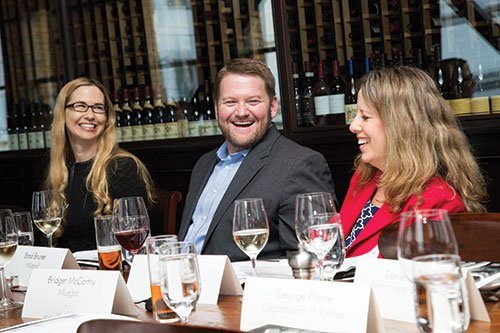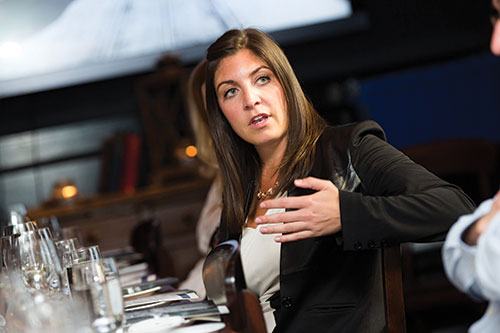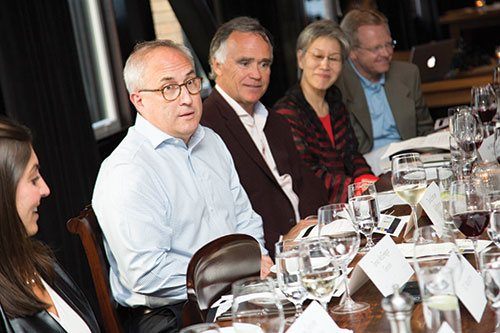
People go in-house for a variety of reasons, such as wanting to be more involved on the business side, and a desire for greater control over their schedule. The notion of in-house lawyers clocking off at 5pm went out with the dodo, but many in-housers report less fetishisation of the jacket-on-the chair culture than in private practice.
However, the gap is certainly not what it used to be. In the Bay Area start-up community, the culture in the early years – including for the GC – is to sacrifice everything to ensure the venture is successful. Nevertheless, what often sets the in-house experience apart is control over one’s schedule, as Josh Horowitz of Tilt explained: ‘I realised that if I actually wanted to create it, I could; I make time for other things and I find it’s really productive. You have to refresh yourself in order to be productive again, otherwise you just keep doing the same thing and it doesn’t work.’
Working differently
For David Smolen at private equity firm GI Partners, it’s a case of working differently:
‘I think that most of us have that concept of baking it in and taking your free time with your work time. Our roles don’t lend themselves to taking a two-week, “don’t call me” vacation. The key is to make yourself more available – both inside and outside of the office – and as a result have more flexibility with your schedule than in a highly regimented structure.’
While the thought that in-house jobs are for those who couldn’t or wouldn’t make it in private practice lingers in some quarters, in the Bay Area (including Silicon Valley) – and the tech sector specifically – in-house is the hot ticket and is often where the most talented lawyers end up. This is partly due to the start-up ethos. Law firm partners will generally make more money than in-house lawyers. But for those lucky in-housers who come on board in the early days of the next Apple, Google or Facebook, stock options can mean that the sky’s the limit. This has generated interest in going in-house, particularly around the five-to-seven-year-qualified mark.
But what qualities do in-house teams consider when hiring? I asked our guests, both in the tech sector and outside, how difficult it is to find the right person for the job, and what they went looking for.
Cultural fit
Overwhelmingly, cultural fit was top of everyone’s checklist for new hires. Eileen Evans, deputy GC at Hewlett-Packard (HP), commented: ‘During the interview process, in addition to ensuring that the candidate has the requisite subject matter expertise, we place a great deal of emphasis on determining whether the candidate also has strong interpersonal and soft skills.’ Jennifer Morrill, deputy GC at LinkedIn, concurred and uses her business team to provide another layer of judgement: ‘You have to see if they have the cultural fit, and that’s when you introduce them to a bunch of people in the business and you get a lot of good feedback.’
There was a consensus that softer skills and experience were most compelling: Linda Drucker, associate general counsel at Charles Schwab, argued that: ‘It’s more important what candidates have done in their last job than which law school they went to. I may have been hired in part because I have Ivy League degrees, but in today’s job market I don’t value those academic credentials as much.’
So how does one measure these more intangible qualities?
Measuring intangibles
Google can certainly take its pick of personnel, and no shortage of applicants want to be ‘Googley’. Catherine Lacavera, Google’s director of IP and litigation, said that a lot of work is done pre-interview by researching candidates’ backgrounds and taking up references. In common with other companies it’s not the resume that is key, but neither is it about ‘the exact things you’ve done. It’s more, how adaptable you are to new scenarios. You can deal with the known, but how are you going to deal with the totally unknown?’
Let’s face it: lawyers are generally at their best when dealing with tangibles and precedents. But how do companies like Google, working in areas where the law may be playing catch-up with their strategies, find the people to cope? For Lacavera, it’s an extensive interviewing process about lateral thinking: ‘We do these hypotheticals that really have no answers so we can watch the person think through that, and see how they are on their feet. Sometimes they are legal scenarios; sometimes they are some weird things that happened to us that week. Other questions will focus more on management style.’
In-house recruitment expert (and former Yahoo legal alumnus) Brad Bruner at MLegal said that this approach is becoming more and more common, particularly in Silicon Valley. The value of such hypothetical scenarios is two-fold, he explained – to see if the person thinks in the right way but also, more fundamentally, to check they are not freaked out by working in an unpredictable environment.
Karen Clopton has just finished working as interim GC at The California Public Utilities Commission (CPUC), where she still serves as a chief administrative law judge. In common with Google, the CPUC also uses hypotheticals: ‘It’s very important to present them with the hypotheticals, and to make it fair for all the applicants, we ask the same kinds of questions.’ However, she continued: ‘But I am interested in how the attorneys, as well as the judges, manage their time and how they manage small projects and large projects, short-term deadlines and the long-term horizon. Because there are run-of-the-mill activities that lawyers do and then there’s the glamorous and sexy energy project that everybody wants to do. I need someone who isn’t going to cherry pick. So, time management and being able to show me that they have good case-management skills are important in that interview process.’
At LinkedIn, said Jennifer Morrill, those who make it through the interview stage are brought back for a staged negotiation session: ‘That will let us know whether they are risk-averse (which we don’t want), or if their drafting skills are good, and how colloquial they are in speaking about terms. It works extremely well.’
Examining cultural fit in regards to outside advisers has been of crucial significance for Josh Horowitz of Tilt; particularly those advisers’ understanding of how he and the company work: ‘It’s more about the method they use to deliver the services, and that they’re tailoring the risk tolerance to what I care about. So, if I ask them for some practical advice and they include different legal things for stuff that doesn’t matter, it just bothers me. Having outside counsel that can ask the right questions so I don’t have to translate what they’re doing – that just makes my job easier.’
GI Partners’ David Smolen, like Horowitz, felt that fit can often primarily be determined via service delivery: ‘Is it concise? Is it actionable? Does their work product show you that they understand how we operate? In law school and at law firms there is often an emphasis on writing legal memos. In most instances we don’t have time for a memo!’
Christianne Chen, managing director and associate general counsel at Prologis, a global industrial real estate investment trust, felt that the fit between external counsel and the business people is also crucially important: ‘There’s a complementary mix that can happen where you can maximise the strengths and minimise the weaknesses, resulting in upraising the whole team.’
Linda Drucker at Charles Schwab added: ‘I hire a lot of lawyers to represent us in arbitrations, which are held in a small conference room. It’s being together for an entire week and if somebody doesn’t have that ability to connect, and isn’t likeable, then they can be the best lawyer in the world, but you’re not going to win if your lawyer isn’t able to relate to the arbitrators the way the other side does’. Jennifer Morrill summed it up thus: ‘It is as important for outside counsel to have EQ as it is IQ.’
Lauren Grause, senior manager of insurance services at RPX Corporation, is in charge of the company’s panel counsel program. She argued that for outside advisers it’s also a case of horses for courses: ‘I’m also trying to look from a more global, big-picture level and see what we really need as part of the team, what component can ease the flow, and what skills these people are able to bring to really make sure that the whole team is unified. Sometimes that may be a cultural fit, but other times it may be that we need a little bit more of a technical aspect or we may need a little more of something else.’
Mixing it up
Can too much cultural fit be a bad thing for talent management? What is the role that diversity can play?
Catherine Lacavera at Google commented that when establishing her team, ‘one thing I noticed was that my first hire was fantastic. My second hire was also fantastic. My third hire was fantastic too, and then it was brought to my attention that I seemed to be hiring people of the same personality type. We had to broaden our view of what would make a good litigator. As you get a bigger team, to have a holistic diverse team, you need some variety. So, for us, broadening the view of what’s a good litigator also involved changing our view of “fit”.’
Law firm Baker & McKenzie’s GC, Peter Engstrom, has embraced this notion of complementary difference: ‘We’re in the process of hiring someone who is going to work in Belfast, Northern Ireland, and I actually wanted someone different than I am. I was thinking, what does this candidate bring to the table that I don’t have? How will she complement me? I don’t want someone who looks like me, thinks like me, who just regurgitates, nods and says yes. That was part of my cultural litmus test.’
The CPUC’s Karen Clopton also chairs the State Bar of California’s Council on Access and Fairness, and is therefore well-versed in diversity: ‘We encourage in-house counsel to look at diverse candidates and to retain diverse outside counsel. We know from our experience with judicial candidates that there are many very well-qualified and numerous diverse candidates, and we are working to educate the legal profession not to overlook the diverse talent pool. We also seek to provide ample leadership development opportunities, and encourage legal employers to go beyond the narrow constraints of a job description in recruiting and retaining diverse talent.’
Hiring diverse inside and outside counsel was certainly a goal for everyone in the room, especially when bringing in the next generation of leadership. Linda Drucker of Charles Schwab stated that: ‘We also want to see diversity in leadership style. We don’t want everyone to think: “well, I have to be the stereotypical white male from Mad Men in a business suit”. You have to be yourself and you have to lead from an authentic place of who you are. And that may be very different for a woman, or an African American, or a Latino, or a gay person.’
Diversity is not just about identity but also about experience. Most of our guests felt that the more legal teams can vary their hires’ experience, the better the outcomes for everyone concerned. A number spoke of the positive outcomes gained from rotations into the business.
Eileen Evans felt that such an experience had fundamentally helped her as an in-house lawyer: ‘I rotated into a business role for nine months, and it was quite transformative and a tremendous learning opportunity. Previously, I had always looked at issues through a legal lens, but during that time period, I began to learn to look at issues through a business lens as well. I believe that the experience helped me to broaden my understanding of issues and become a better business lawyer.’
The prevailing view among those present was that a siloed approach to legal did not produce a good overall experience for the company, and as Catherine Lacavera commented: ‘I do think the flexibility that we’re talking about creates a better culture of retention.’
Variety – the spice of life
Lauren Grouse of RPX pointed out that variety is inherent to the in-house role:
‘In a law firm there’s just the one linear path, whereas an in-house environment provides more opportunity to work with different targets, or on different initiatives or programs within the company that may need legal support.’ However, lack of linearity may also feel like a lack of tangible progression for the ambitious in-house lawyer, and addressing this has become a priority for some legal teams. Hewlett-Packard provides a particularly good example of this, as Eileen Evans explained: ‘The core of our talent management strategy is the notion of building a sustainable talent pipeline through hiring entry-level talent and developing career paths from entry-level positions to senior leadership roles. We start with bringing junior attorneys into HP as 2L summer associates. Upon graduation, they can join our litigation, intellectual property, corporate securities, or mergers and acquisitions groups. After a few years of hands-on experience in these groups, the junior attorneys can choose whether they want to deepen their skillset in their chosen area of specialty, or move into a commercial role supporting one of our business units. Thanks to the career maps we’ve developed, charting an attorney’s progression from entry level to director or VP level, there are a number of different available paths, each of which will develop our attorneys and prepare them to take on leadership roles.’
Trying to build structure within notoriously flat in-house legal departments can have its limitations though. Linda Drucker of Schwab commented that: ‘We hire these young, ambitious, very talented lawyers and they do the job really well for two years. And then they say, “oh, when am I getting a promotion?” And you can’t just promote everyone who’s doing a good job after a couple of years because you’d end up with a top-heavy organisation full of SVPs and nobody else. So we have to look for other ways to help people develop their careers.’
Jennifer Morrill at LinkedIn went on to describe how for many departments, balancing career opportunity and portfolio enhancement with the specialist needs of the team can be a challenge. ‘I think there are limitations to transferring people. That work needs to get done and you can’t always rotate people around if you’ve got contracts that move fast and furiously.’ Christianne Chen of Prologis agreed: ‘If there’s an opportunity for rotation and I end up moving one person, I’m going to have seven people who are very unhappy!’ In her experience, team members’ desire for promotion can lead to some home truths: ‘I think people want to get promoted because it’s the next step. It’s not necessarily that they’re best suited for the job. A lot of lawyers are great technicians and they’re great from a competency and substantive standpoint, but they may be really bad at managing people. It’s important to have honest (and sometimes difficult) conversations with your team about, “why do you want it? Is it because of money, prestige or because you have the necessary skills for the next level? What do you think are your strengths and weaknesses?”’
But there might still be flexibility for other opportunities. As Karen Clopton of the CPUC pointed out, the public sector has a long pedigree of internships and pro bono programs rather than formalised rotation: ‘We call them “leadership development opportunities” – whether it’s the volunteer co-ordinator raising money and awareness for the food bank, planning the year-end holiday get together, serving as liaison with the support staff, or otherwise contributing to team-building activities, these opportunities give lawyers (and judges) an out-of-the-box experience. It also allows these attorneys to get valuable management experience and to interact with their colleagues, and not just in their practice groups. Whether they are advising the attorneys, or working on safety and enforcement or governance issues, they all come together as a team.’ Eileen Evans noted that many of HP’s junior attorneys have taken roles including ‘leading the nationwide Pro Bono Committee or the social committee at various sites. Through these activities, new attorneys are able to hone their leadership skills, give back to the community or their colleagues, and forge connections with colleagues in new and different ways.’
Scaling up
Determining the skillsets needed at different stages of an organisation’s life is key, particularly for the start-up and early-stage community, where companies may undergo radical shifts. Josh Horowitz at Tilt has been preparing himself for changes in his company and his role. He recalls how he asked the founder of a large public company, formerly a start-up, whether GCs can scale with a company. The founder’s answer was no. He had replaced his GCs every two to four years because there were different challenges at different scales, necessitating someone with different skillsets.
While Horowitz fundamentally disagreed with this, he told us: ‘Right now I’m thinking about the next set of skills that are needed and how to get them. We just did a 360 review throughout all of management. It was awesome, because one of the things that I learned from this was that the company would like me to do more operational things, more strategy for the business, which to me is amazing.’
This has been key to Josh’s own development as a GC: ‘What are the skills that I’d want to develop? I think the kinds of things that I need to do are not that different than what CEOs do. Well, there will be some variance at the edges. But if I can think like a CEO, that just makes me so much better overall.’ Lauren Grause of RPX concurred, commenting that ‘in-house lawyers need to develop and be flexible, and to pull it off you have to develop and manage a dynamic team, which is somewhat of a weak place for legal professionals.’
As the evening concluded, all of our attendees agreed that despite the challenges, talent management is also one of the most rewarding aspects – when it all comes together.
In attendance
Brad Bruner, MLegal
Christianne Chen, Prologis
Karen Clopton, California Public Utilities Commission
Linda Drucker, Charles Schwab
Eileen Evans, Hewlett-Packard
Peter Engstrom, Baker & McKenzie
Lauren Grause, RPX Corporation
Josh Horowitz, Tilt
Catherine Lacavera, Google
Joe McCrae, MLegal
Bridget McCarthy, MLegal
Catherine McGregor, Editor-In-Chief, GC
Jennifer Morrill, LinkedIn
David Smolen, GI Partners
Venue
The Wayfare Tavern, San Francisco






